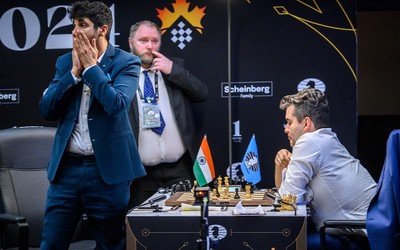
2016 WCC, Game 4: 2 Marathons in 2 Days
Will fatigue defeat one of these masters?Game 3 was an epic marathon that lasted almost 7 hours. We posted this in our Game 3 article, but in case you missed it here is Carlsen and Karjakin after yesterday's game.

Carlsen and Karjakin have spent their lives flying around the world, playing in every time zone, and with little sleep. They have both had to play through the heartbreak of a loss and the overconfidence of success. Will it affect their play?
Game 4
The game opened similarly to Game Two with Karjakin opening with the Ruy Lopez and Carlsen responding with the classical variation. As Karjakin didn't present any real threats to Carlsen in Game 2, it was interesting to see what else Karjakin had prepared in this perennial World Championship favorite. The first difference from Game 2 was Karjakin's 6.Re1. He made the Anti-Marshall move 8. h3 and slowly built up an attack on the kingside.
Below is the position after Carlsen's 15th move. What would you play here as white? As you can see, lichess recommends 10.Ng4, but that's not what Karjakin played.
Karjakin played 18.Bxh6, Carlsen responded 18...Qc6, ensuring he'll win the e4 pawn with excellent piece placement. In the post game press conference Karjakin said he thought Carlsen would respond with 18...Nxe4, and when Carlsen played 18...Qc6 Karjakin thought, "what have I done?" Karjakin then traded off his Ruy Lopez light-squared Bishop for Carlsen's c4 knight, which some felt gave Carlsen a strategical advantage. It was at this moment I stopped caring about chess for a couple of hours.
I start caring about chess again in about 2 hours. If you just care about chess, you should skip to "What is going on in the game?" But if you want to embark on a journey that will change your life forever, read on, but prepare to never be the same.
The journey begins with me buying a normal box of cheese.
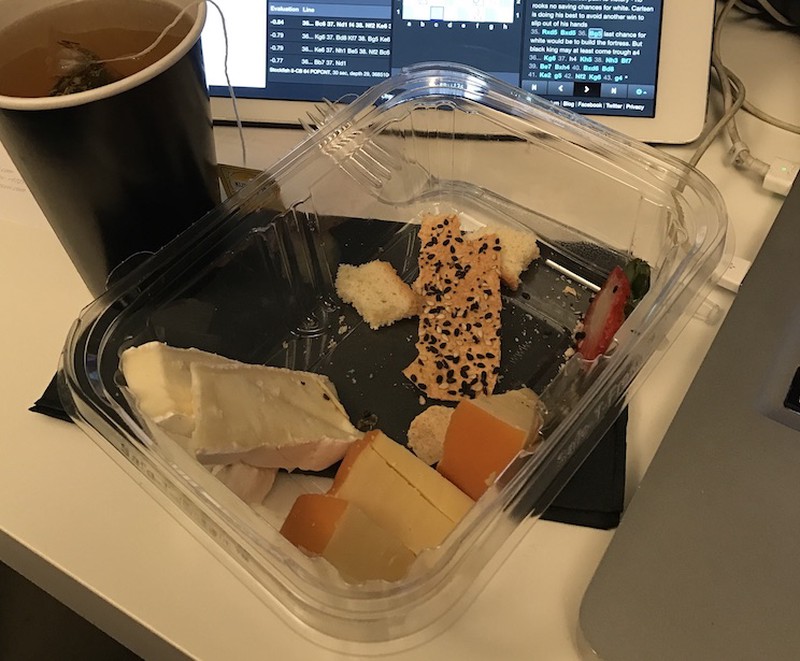
My first thought as a journalist was, you don't often see cheese in boxes, that's because cheese is usually manufactured and transported in wheels. It seems like an inefficient use of space to transport wheels in boxes. We all know the saying "you can't put round cheese in square box." Well World Chess sure showed whatever fool said that who is boss! World Chess will put their cheese in whatever shaped receptacle they please.
But let's get to what's important: how was the cheese? The cheese was fine. There were 4 different varieties of cheese in the box. I'm American, and therefore a cheese novice. Despite my nationality, I could identify the soft cheese as Brie. None of these cheeses had holes, so I'm pretty sure none were swiss. I did not care for the yellow cheese with the orange rind. I still don't care about chess.
But the concept of a cheese box would stay with me, and what I would uncover next would change me forever. I hope you're sitting down before you see this next picture, and if you have a heart condition, I would consult a doctor before continuing this article.
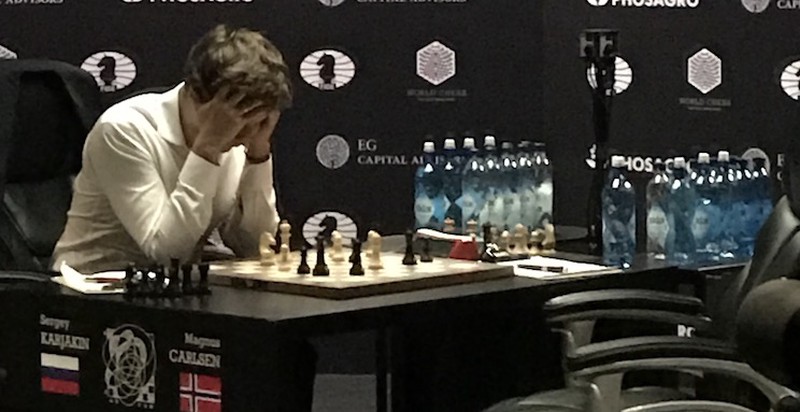
Take a close look at this picture. World Chess is providing Magnus Carlsen and Sergey Karjakin with WAY too much water. I'm going to make a bold claim: if there's more water bottles on the table than pawns, something's not right. That's when it hit me: Games 3 and 4 have been so long because there's too much water on the table. Think about it. You're Magnus Carlsen, you show up to defend your World Championship against one of the best defenders in the world. You arrive to the playing hall and there are 8 bottles of water on your side of the table. It implies that you are in for a long battle. Why else would you need all that water? Here's where things really get crazy, did you notice what shape the water bottles are in, a rectangle. Is a rectangle a square? Sometimes. The water bottles are arranged in the same shape as the cheese box. Buckle your seatbelts, this rabbit hole of strangely abundant liquids is just getting started.
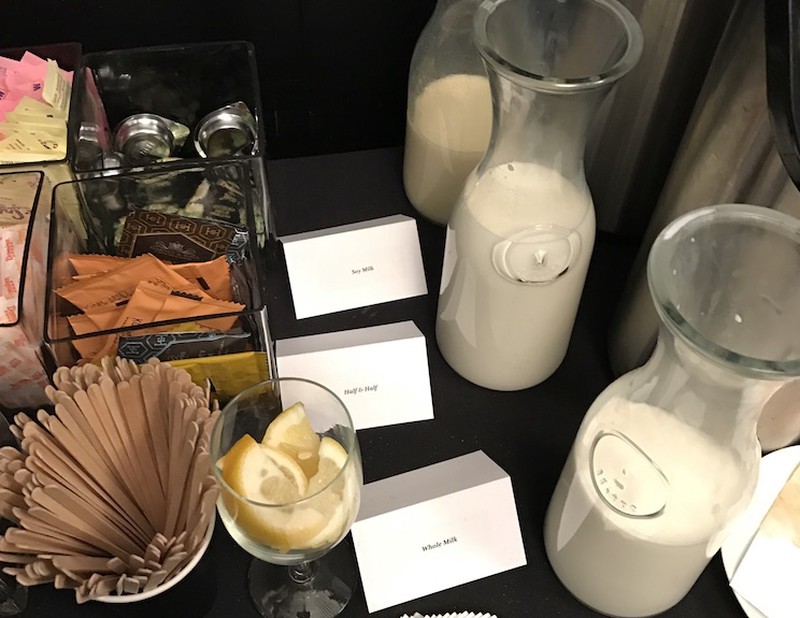
The Press Center is well stocked with milk. Maybe a little too well stocked? There is coffee next to the jugs of milk, so whomever or whatever put the milk here was crafty. They wanted us to think the milk was for the coffee. But there is simply too much milk. Now maybe if there was a 55 gallon barrel of coffee, now I can see why you would need all this milk. Why all the milk?
I'm not sure how cheese is made, but I'm pretty sure if you leave this milk here long enough it will turn into cheese, I could be wrong. But i'm pretty sure that's how it works. And notice the shape of the jugs: circular, the shape that cheese is traditionally made it.
Then I discovered the truth of what's really going on. It's so simple. We're stuck in a time loop, a self perpetuating loop that no one will ever be able to escape. Because time is in a loop, it has no beginning or end, but here are the components to the time loop. World Chess has over supplied Carlsen and Karjakin with water, implying that they're in for a long game. Little do they know now there is only the game: Carlsen will always be attacking, Karjakin will always be defending. Then there's the over-abundant milk supply, have you figured it out yet? The cheese box, and the milk in the press room are one. What the journalists don't drink slowly turns into cheese, and sold back to us in boxes, so we can watch the never ending game of chess. To close I just figured out we're all Sisyphus, pushing our wheels of cheese up the mountain, but as the french philosopher Camus said, "we must imagine Sisyphus happy." I care about chess again.
What is going on in the game?
All joking aside, this game is another monumental defense for Karjakin. After move 18, Carlsen held a slight advantage. But would that advantage be enough for a win? Carlsen pressed for 76 more moves. Let's look at two key positions that demonstrate Magnus' advantage, but also how difficult it is to convert that advantage into something more tangible. Here is the game after white's 28th move.
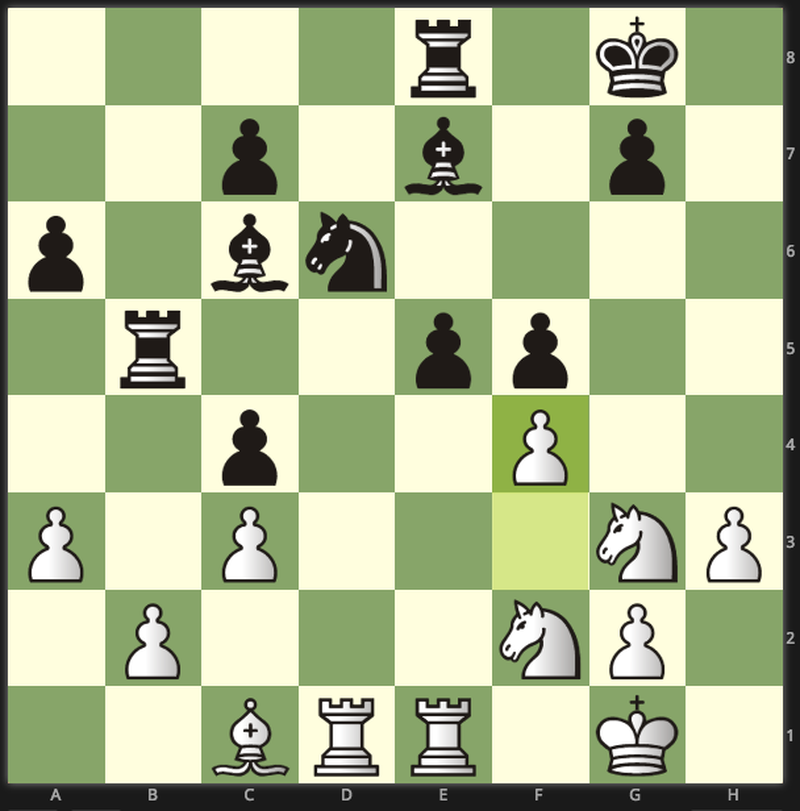
Carlsen has an advantage that can be summed up in a couple ways: black has the bishop pair, black has a potential passed pawn on e5, black has better piece activity. But how can you use these imbalances to win the game? 28...e4!? is a bit premature as white can easily relocate his g knight to e3, blockading very well. 28...exf4 concedes the d4 and f4 squares to white. White would quickly relocate his knights, and most likely build a fortress that would be difficult for black to storm. Magnus chose the optimal continuation, 28...Bh4. This activates the bishop and prepares to put it on the h2-b8 diagonal. This bishop will be guarding a key backward pawn that will appear in the next couple moves.
Here's another mysterious position from the 43rd move of the game, again black to move:
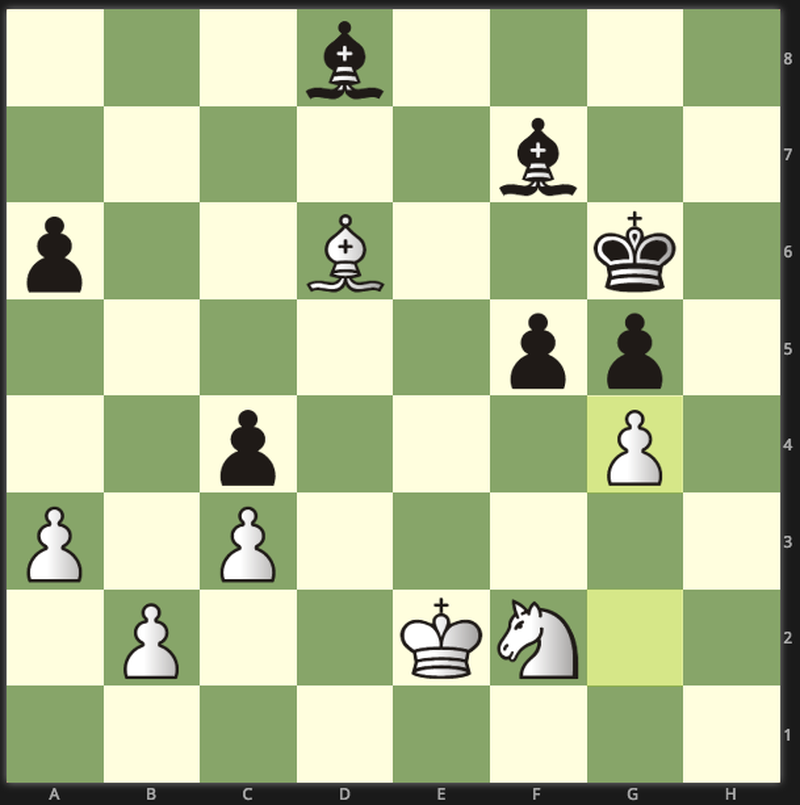
Magnus Carlsen thought about this position for 20 minutes. Can black win? If black plays f4 right away, white's king can quickly come to f3, blockading the pawn. Carlsen decided on 43...Bb6, keeping the position flexible, not wanting to make committing pawn moves until he has no other choice. Magnus did push on f4 on move 45. In retrospect f4 is regarded as a mistake, because it releases tension and makes white's defense easier. It's interesting that in games 1 and 4 have Magnus played f4, a committing pawn move that made Karjakin's defense easier.
Karjakin simply kept his King back and waited to see if Carlsen could find a way to break through. Carlsen tried moving his King all the way to a2, and Karjakin kept the king under control by shuffling his king between c1 and c2. The dark squared bishops were exchanged, but it still didn't help Carlsen. A draw was agreed on move 94.
Where do we stand after four games?
Everyone is tired. Even Carlsen said he could use a rest day. I am blown away by Games Three and Four. The pure stamina shown by both players is almost inhuman, the accuracy, the commitment, and the will to win, or not lose, is unreal. Karjakin is in better spirits as he was able draw both games. But Karjakin has never had an edge in this match, for him to think about winning, he will need to stoping thinking about drawing. Carlsen kept repeating the phrase "on to the next" after Game Four in regards to his spirits after these marathon games. He's frustrated, but you can sure he will be ready for another fight on Thursday.
To me the final thought is: Karjakin can defend, but can he win?
About the Author:
Tyler Schwartz is a passionate chess ambassador. Tyler is the President of Chess at 3, teaching chess to children all over the world at the suprising age of 3. He is the Head of Media at lichess.org. Tyler also manages a chess club on the upper east side of Manhattan.
More blog posts by Lichess

Round 14: Gukesh and Zhongyi are officially the World Championship Challengers
A historic finish to the FIDE Candidates, as 17 year old Indian prodigy becomes the youngest World C…
Candidates Round 13: Gukesh takes the lead, Zhongyi pulls ahead
A massive day for the 17 year old Indian, as his chances to win the Candidates skyrockets, as Zhongy…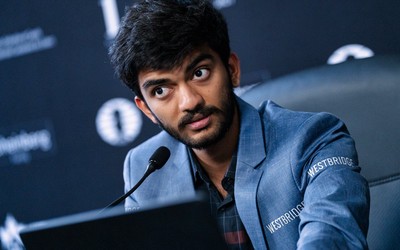
Candidates Round 12: Three-ways Tie in Open, Tan Maintains her Lead
Nakamura and Gukesh catch up with Nepomniachtchi in Open, while Tan maintains a safe distance from e…